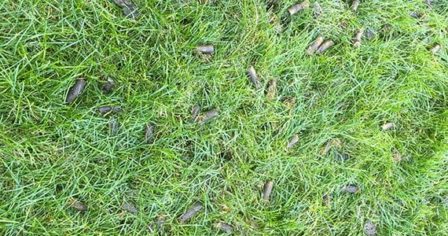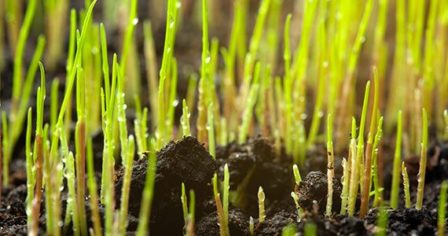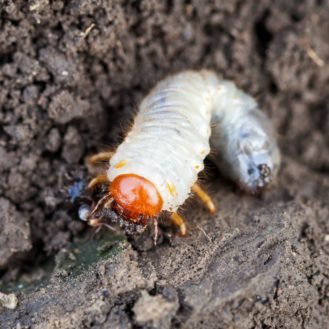Almost all of us know “that guy.” He’s the one in your neighborhood who is fanatical about lawn care. In my neighborhood growing up, we called him the “Samurai Gardener” – he was constantly wearing a headband that conjured up images of Jim Belushi’s “Samurai” skits of Saturday Night Live fame.
This person speaks authoritatively about the subject matter of all things “green.” When to mow, how often to mow, what products to apply to your lawn, how much to mulch, when to trim your shrubs – this list could go on and on. The sad reality, however, is that many of your “expert” neighbors are anything but that. Here, we’ll debunk 5 Vicious Myths about Lawn Care.
Myth #1: Rolling a lawn
Every single year, we hear something similar from clients. The conversation usually starts with “My lawn is really uneven.” At other times, it is “My lawn is really bumpy when I mow.” Then the inevitable question: “Do you roll lawns?”
The question is asking about a practice that is, unfortunately, very common in Central Pennsylvania. Many people own “lawn rollers,” which is essentially a miniature version of a steam roller you’d see for paving roads, hitched to the back of a tractor. It’s a large metal cylinder that, when dragged behind the tractor, is supposed to “smooth out” the bumpiness of a lawn.
Don’t do it!
The answer to this is that, no, we do not roll lawns. We have what is known as “clay soil” to scientists. Clay soils tend to stick together, and get incredibly hard and compacted over time. Your trees and shrubs have a very dense, woody root structure, allowing them to cope with this compaction more easily. Your grass has much finer root structures, more like hair, and cannot push through heavily compacted soil.
Because we know that our soil is prone to this compaction, which happens with just normal wear-and-tear from walking on the lawn, driving your mower across the lawn, the pets and kids running on it, etc., why would you then hire someone to drive a massively heavy piece of equipment across the lawn, making it even harder for your turf to get the nutrients and water they need? This doesn’t make much sense, so we do not recommend it.
Solution
It’s a much better idea to something called topdressing a lawn to address the bumpiness. Topdressing and seeding involves overseeding a lawn and then applying a thin layer of topsoil or other organic matter. The layer of soil acts the same way mulch does in your flower beds; it keeps in moisture, prevents the ground from drying out, keeps the seed warm and moist so it can germinate properly.
Raising the soil level and introducing organic matter is, agronomically, a much better solution for a “bumpy” or “uneven” lawn than rolling.
Myth #2: Aeration doesn’t do anything
Core aeration is a process of taking a piece of equipment across the lawn that pulls plugs (or “cores”) out of the lawn. This is important for two reasons: 1) it stimulates root growth in the turf, and 2) it softens the soil by introducing oxygen (hence the term aeration), which allows those roots to spread. It’s how you combat that compaction in the soil that we learned about in Myth #1 about “rolling” a lawn. In fact, Penn State’s Center for Turfgrass Science recommends core aeration as “…probably the only means of correcting or alleviating soil compaction…”
One of the most common objections we hear when aeration is recommended is “I aerated it two years ago, and I didn’t see a difference. I don’t think it does anything, so I’m not going to do that again.” The assumption here, which is what makes it a myth, is that if you’re doing something for the lawn, you should see an instant, tangible impact.
Not seeing is believing…
Having the turf aerated isn’t like fertilization or weed control, where you see the results almost immediately. Within a few days of fertilizing or treating for weeds, you see the lawn green up and weeds curling and dying. It’s as close to instant gratification as you can get with something growing in the soil. Those things are like the gas you put in your car – they make it run! And, you’d notice when you’re out of fuel, wouldn’t you? It’s immediately apparent, just like fertilization and weed control.
Aeration is a lot more like changing the oil or the brake pads on your car. It’s something that is unseen and kind of “behind-the-scenes” if you will, but you definitely notice when these maintenance issues are neglected! It’s the same way with core aeration. You’ll begin to see a decline in the turf, and you might even begin to see turf diseases. When the soil is compacted, water cannot pass through the soil the way it normally would and water sitting on the soil surface for long periods is a breeding ground for turf diseases.
Solution
This one is really easy. Make a regular plan, whether it’s annually or bi-annually, for aerating the lawn. And stick to that plan.
Myth #3: De-thatching
Again, as a lawn care company, we hear this question a lot. “Does your company de-thatch lawns?” And again, the answer is “No.”
Thatch is a layer of organic material that builds up on top of the soil. Grass clippings usually make up the majority of the thatch layer in a lawn. When thatch is too thick, it can affect the health of the turf.
Pulling up the turf
De-thatching is a process where, either mechanically or manually, there’s essentially a raking of the turf that pulls up this organic material, exposing the soil itself. This is not generally recommended, as this process can tear your individual grass plants and put unnecessary stress on the turf.
Two points to note here. First, a small thatch layer is healthy for a lawn. It holds in moisture and prevents the soil itself from drying out. Secondly, the thatch layer is full of decaying organic matter, which as it breaks down, only compliments your regular lawn care program.
Solution
Regularly performed core aeration of the lawn will help to break down the thatch layer more naturally. It will accomplish this without the additional stress that de-thatching puts on the turf.
 Myth #4: Spring seeding
Myth #4: Spring seeding
Our home improvement stores’ marketing efforts are partially to blame for this one. Every time you turn on the television or open a magazine or newspaper you’ll see advertisements for spring gardening tasks. Inevitably, specials on “grass seed” are on this list. They’ll tell you that now (meaning Spring) is the time to re-seed your lawn and get it healthy looking again. Do it now! Otherwise, you’ll miss out!
That’s only partially true, and this myth really stems from a fundamental misunderstanding of turfgrasses in our area. Turfgrass, generally speaking, falls into two categories in North America: warm-season grasses and cool-season grasses. Warm-season grasses like hot weather, and generally grow best in places where it’s warm most of the year (think Deep South). By contrast, cool-season grasses grow best in cool weather, which means Spring and Fall for our area. And, being that these grasses (like fescue, bluegrass, and rye) prefer cool weather, when it’s hot (June, July, August in our area) they usually enter a period of dormancy. Think of a bear hibernating for the winter.
Maturation process
The problem comes from the time it takes for these grasses to mature. You can almost certainly grow grass in the Spring here in Central Pennsylvania. The problem is that you won’t likely keep that grass around all year, because cool-season grasses, generally speaking, take about six months to fully mature. That means that if you plant in the Spring, you have to try and keep those immature seedlings alive through June, July, and August, when it’s hot and dry, and you lose most of that work you put in.
In addition, the first task for any credible lawn care profession in our area is to apply a pre-emergent herbicide, otherwise known as a crabgrass control. These products work by putting a barrier in your soil that controls anything in the “grass” category. Basically, when something grassy starts to grow in your lawn, it comes into contact with this barrier and is prevented from reaching maturity. That is the only truly effective way to prevent crabgrass. The old adage holds up: “An ounce of prevention is worth a pound of cure.”
Because these products control all grassy plants (and occasionally some broadleaf weeds) from growing, they’re going to be detrimental to growing new turf as well. These products don’t distinguish between crabgrass germinating in your lawn and bluegrass or rye. They prevent all grassy seeds from germinating for a few months throughout the summer, as a general rule. Since preventing this invasive, aggressive weed is of higher priority, we recommend having this done in the spring in lieu of trying to seed.
Solution
Fall seeding is much more effective in our area. If you plant grass in the fall, you should get seed germinating prior to freezing temperatures. That way, you’ll have lawn that’s starting to establish itself before Winter hits. Cool-season grasses with over-Winter just fine, and by late Spring they will have reached maturity, making them far less likely to die out from heat and drought stress in the Summer.
Myth #5: Grubs cause all my lawn problems
Many homeowners are aware of the presence of grubs. Grubs are beetle larvae, with the most well-known in our area being the Japanese beetle. Beetles feed on landscape plants, lay their eggs in the soil, and a few weeks later those eggs hatch. The larvae need a meal to reach the next step in maturity, and they find it in the roots of your lawn. When grubs are present in high numbers, you’ll notice damage to the turf in the form of browning, usually in large patches. The brown areas will roll back, like a rug on a hardwood floor, because the roots have been eaten away completely; there’s nothing holding the plant to the soil.
It (probably) wasn’t grubs…
Here’s the myth: any and every brown or damaged looking spot in a lawn must be from “grubs.” Homeowners have become hyper-aware of this nuisance pest, and blame every problem they see on them.
The truth is far worse, unfortunately. Grubs only cause damage to a lawn in late August into early October in our area. Damage to the turf in that timeframe may well be from grubs. However, the damage you’re seeing to your lawn in July or early August is far more likely heat and drought stress, chinchbug activity, or a turf disease. Grubs are not to blame for everything you see. I’ve even been called out to customer’s home before to inspect dead grass they believed was grubs; it was actually a gas leak in his lawn mower, dripping gasoline and killing turf in a random pattern.
Solution
During the window when grubs are feeding, get down on your knees, grab a handful of turf with your fingers as close to the soil as possible, and pull gently. If it rolls back like a rug, it is indeed grub damage. If it doesn’t roll back, or it’s outside the grub feeding window, your best bet is to contact a professional. They should be able to help you diagnose the issue and offer the corrective treatment. Going to your local garden center or University Extension might get you the diagnosis, but not necessarily the remedy. Make sure the professional you contact can actually help you fix the problem.
Conclusion
Are there other common lawn care myths that we’ve overlooked? Feel free to comment. Also, we’d love to talk to you about solutions for your lawn care concerns. Please contact us for additional information!

